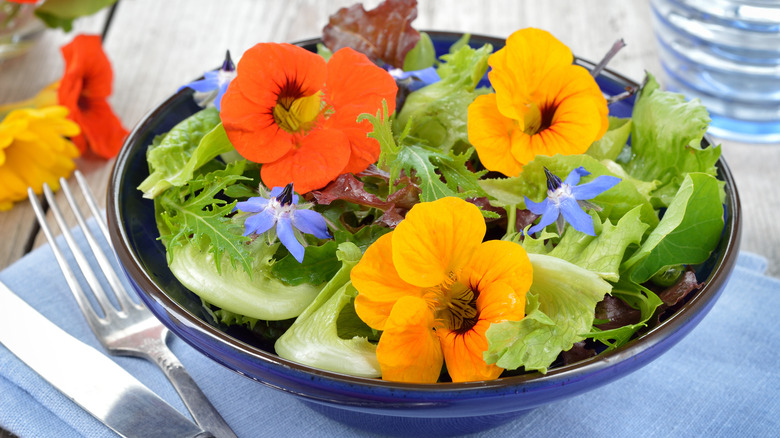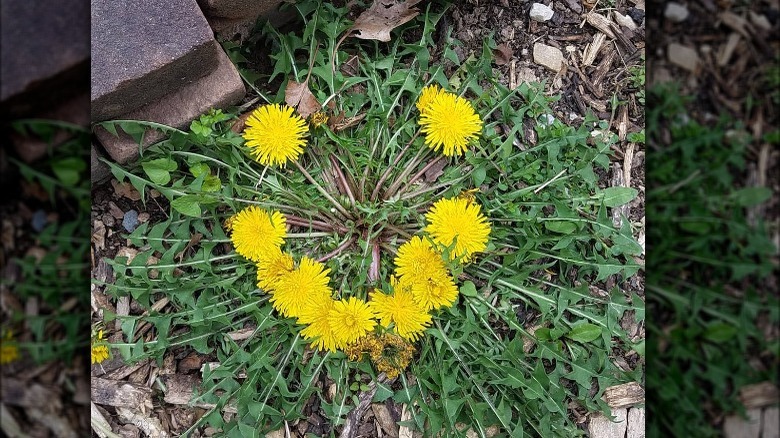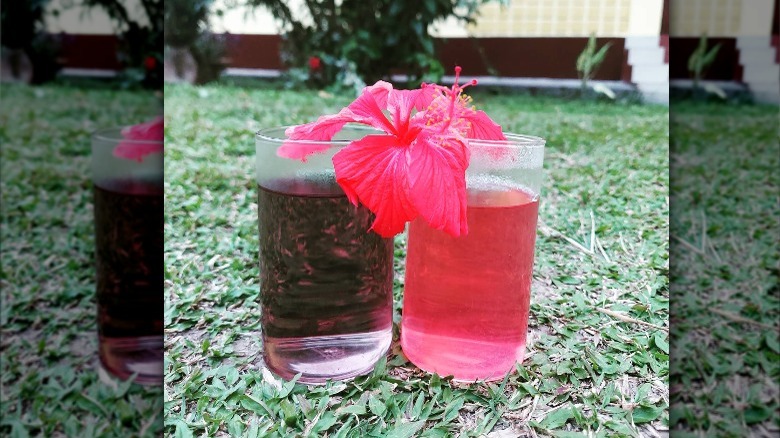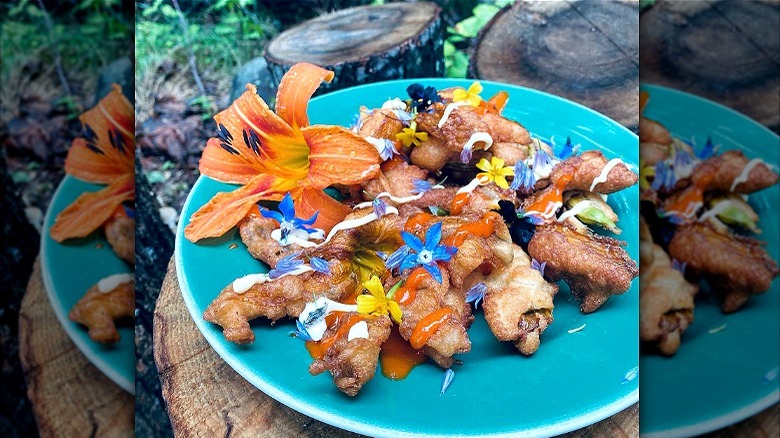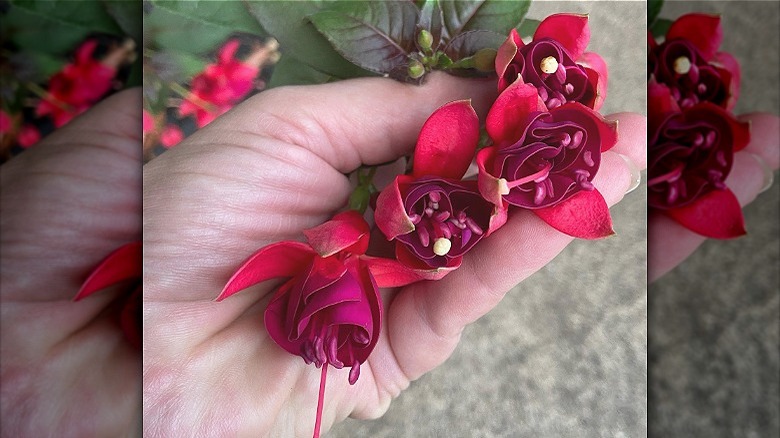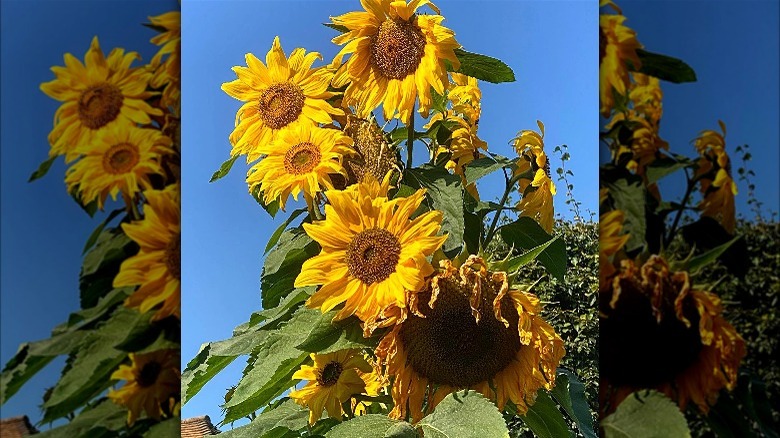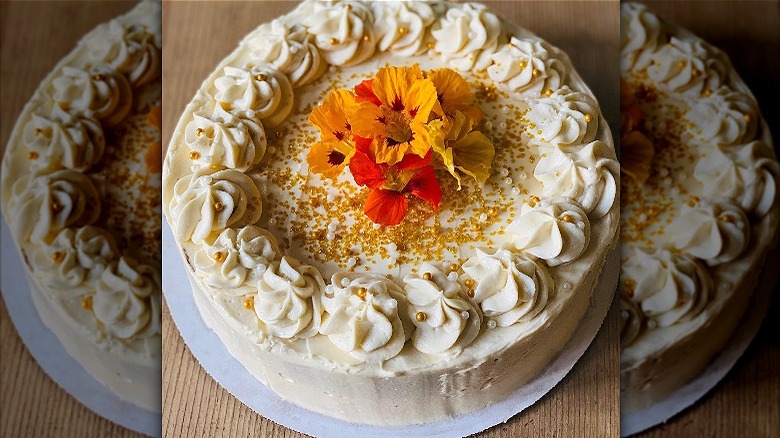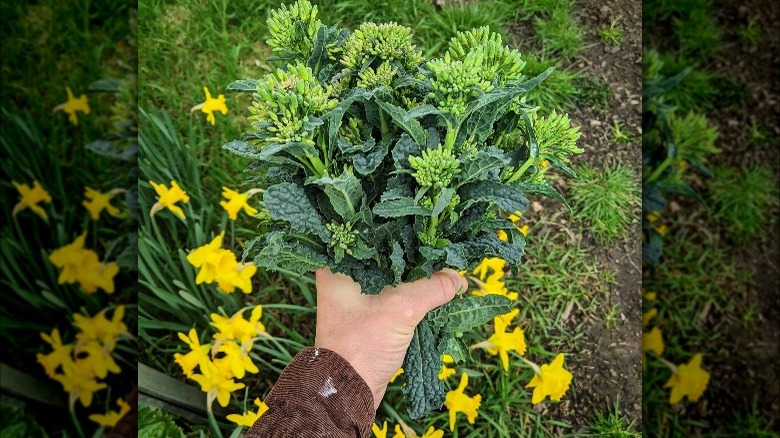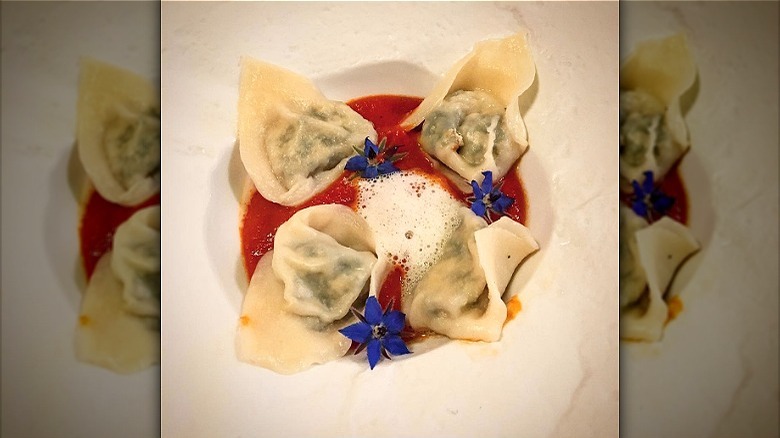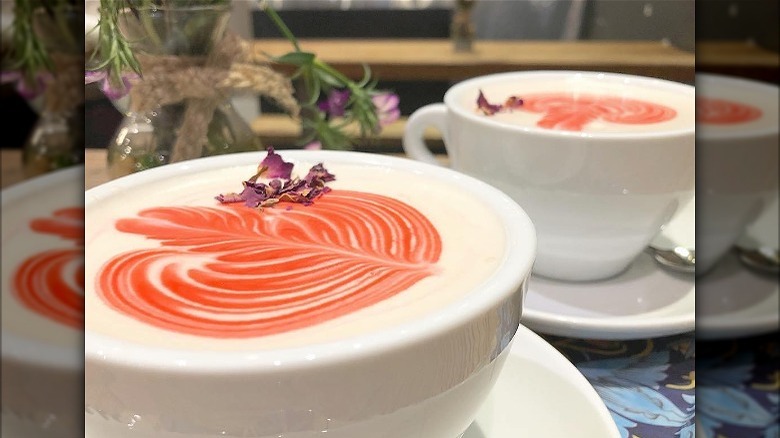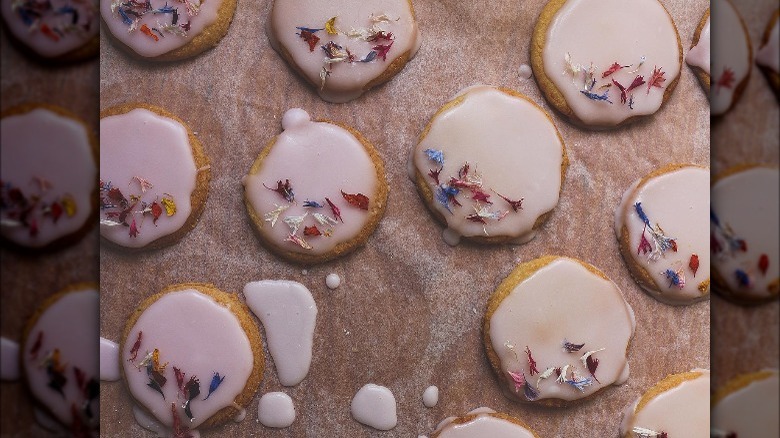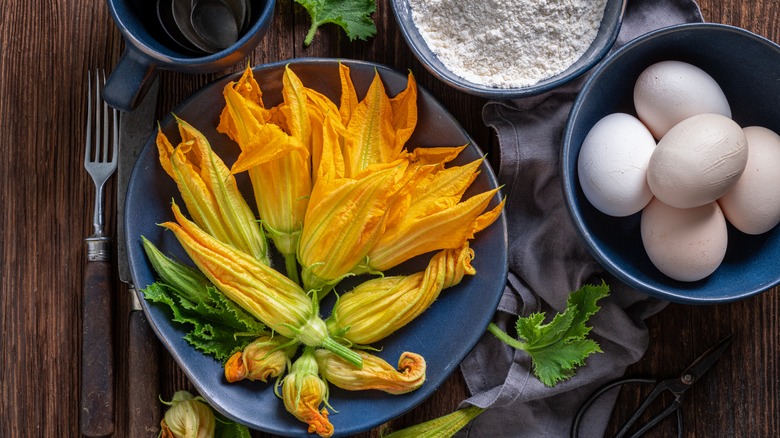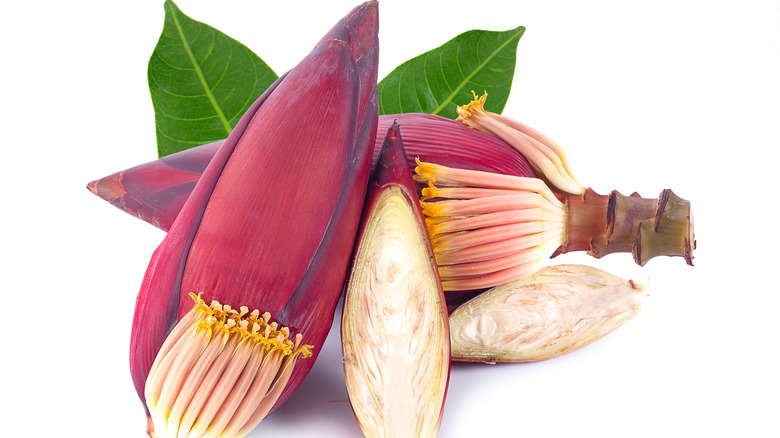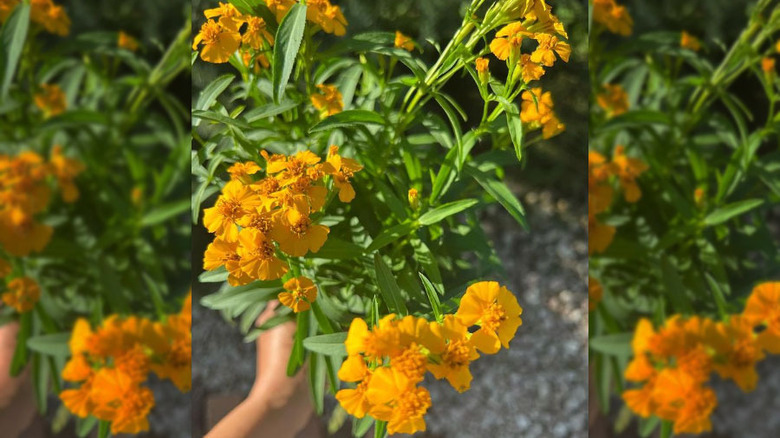13 Flowers You Can Eat From Your Garden
What's a garden without flowers? These beauties liven up wherever they are planted and studies have even linked flowers with elevated mood and decreased stress (via Rutgers Magazine). With this line of thought, it's high time to revisit the concept of flower power.
It's true that many flowers carry a small punch of various nutrients and vitamins, that being said, you would need to eat plenty of these pretties before really reaping the rewards of these nutrients. There are a few medicinal flowers here and there that have an exceptionally beneficial effect on the body.
There is something to be said about the simple pleasure of eating beautiful things. If flowers are able to brighten our gardens, why can't they do the same on our plates? Trendy restaurants have long added bright flowers to garnish their dishes. The much raved about NYC Il Fiorista went so far as to base their entire menu around flower dishes; including flower-decorated cocktails and bloom-infused pastas. There are many ways to cultivate some fresh new takes at home too! Below is a list of 14 edible flowers, their benefits, and how to best enjoy them.
1. Dandelion
The flower that truly needs no introduction. Classified as a weed, dandelions are ubiquitous in North America. But the dandelion doesn't just do well outdoors, it also is a multifaceted addition to the kitchen. Most of the dandelion plant is to be enjoyed, outside its bitter adult stem.
Young dandelion greens can be enjoyed any number of ways: sautéed, creamed, or served fresh in salads. Dandelion greens are sodium-rich, so they can even substitute for table salt in summer dishes. A comforting dandelion soup makes a good companion when fighting off a summer flu; dandelions have even been used as a home remedy to relieve inflammation (via Healthline). Though be sure that harvested dandelions are pesticide-free before enjoying them!
Dandelion roots are an especially healthful part of the plant, although they are much more labor-intensive to harvest compared to harvesting other parts of the plant. It might be easier to seek it out in a local organic store, the dried root can help stimulate appetite (via Mount Sinai).
Dandelion coffee, really a tea, is a popular coffee substitute. It's often referred to as dandelion coffee as it's the crushed dandelion root and has a similar appearance and taste, albeit decaffeinated. For those looking to cut down on caffeine all the while not skimming on a morning (or afternoon) cup, perhaps dandelions are the place to get it with a floral twist. For a nightcap, maybe indulge in a dandelion wine.
2. Hibiscus
Hibiscus stuns with its large bright blooms. There are around 200 varieties of this tropical beauty, though the most common edible hibiscus is the Hibiscus sabdariffa, otherwise known as the roselle.
You may recognize hibiscus from Starbucks' popular hibiscus refresher. In fact, the chain's hibiscus-infused drink was so popular that there was constantly a shortage of it during the pandemic, making it a "clear winner" of the pandemic food industry (via The New York Times).
According to Prepared Cooks, the flavor profile of hibiscus is tart and slightly sour with floral notes. The flower traditionally adds a bright reddest-hue to whatever it is infused with. There are potential health benefits when it comes to consuming hibiscus, the bold flower is chock-full of vitamin C which is a powerful antioxidant (via WebMD). Vitamin C is essential to the body's healing process and also aids in building important things like collagen. Though it would take a lot of hibiscus to have a major effect on overall health, there's no doubt that this flower has a lot of good in it.
Beyond tea, hibiscus' unique flavor lends to versatile use in many different dishes. Hibiscus can be infused with jams and jellies to make for a tart yet bright addition to plates. Hibiscus plays a significant role in many cuisines including Jamaican where it is found in many dishes like Jamaican sorrel punch. Beyond the traditional, hibiscus can be found in anything from tequila spritzers to quesadillas.
3. Daylily
Similar to hibiscus, the daylily makes a bold addition to any dish. The daylily earns its name from the fact that the plant loses its delicate blooms by night, though do not fret, new flowers will open come dawn the next day (via MasterClass). As noted by PBS Food; every part of the daylily is completely safe to eat. But, it's the daylily flower that makes the most beautiful addition to the meal. Served fresh or dried, the bright orange daylily spruces up whatever plate it graces! The flower isn't as sweet as it might appear and its flavor has been compared to that of sweet iceberg lettuce, while that of the daylily buds has been compared to asparagus and green peas.
Daylily blooms are mild enough to be eaten right off the stalk, though do make sure to give them a good washing first. Fresh daylilies make a subtly sweet addition to salads. These bright blooms are a traditional staple of Southeast Asian cuisine, where their buds are usually whipped into different soups. Dried daylily blooms even symbolize wealth on the Lunar New Year dinner table (via The Spruce Eats). Like zucchini blossoms, daylily blossoms are served a number of ways nowadays, including stuffed and served with tomato sauce or made into a fritter. Cat owners watch out! Daylilies are extremely poisonous to felines; even the water they are placed in is detrimental to cats when ingested (via the FDA).
4. Fuchsia
Fuchsia flowers are unique bell-shaped blooms that come in a wide array of colors, though are most commonly deep red and purple. Though fuchsia is a perennial in its native home close to the equator, up here fuchsia is an annual according to Gardeners' World. This plant produces beautiful blooms and berries throughout the summer, both of which are completely edible (via Gardening Know How).
There are some of the many fuchsia varieties that truly have extremely flavorful flowers, though these are much rarer to find in the U.S. (via Gardener's Path). Don't let that be a deterrent! These stateside flowers can be just as tasty, especially for those who enjoy a slightly acidic, bitter taste. Fuchsias can add a nice visual and flavorful pop to otherwise dull summer salads.
For those who with a sweet tooth, fuchsias liven up desserts just as well. Crystallized fuchsia makes a darling accent atop cakes and adds a certain something-something to an otherwise sickly sweet white chocolate. Even in mousse, fuchsia adds a welcome twist.
5. Sunflower
When thinking about American snacks, sunflower seeds and long summer days in the baseball stadium seem to go hand-in-hand. But sunflower seeds aren't the only part of the sunflower that can be enjoyed. In fact, just about every part of the flowering plant can be consumed. Sunflower plants actually have a long history on the North American continent and have been snacked on by indigenous communities long before baseball was ever conceptualized (via Live Strong).
Sunflower buds have a nutty flavor like that of the artichoke and can even be prepared in a similar way. Sunflower petals also have a buttery taste, though it's undercut by a unique floral bitterness. Similar to other bitter flowers, these bright yellow petals make for a bright and interesting way to liven up salads. It's even possible to make a sunflower salad, that is mainly made from sunflower greens and then topped with sunflower petals and seeds (and even mixed with, dare we, sunflower oil?).
Beyond that, there are many ways to enjoy this bright beauty. When mixed with a few other ingredients, sunflower petals make a boldly yellow and summery sunflower pesto. The Nerdy Farm Wife food blog even concocted a sunflower jelly. While most of the flavor comes from lemon, the sunflower acts mainly to stain the jelly a bright and sunny yellow.
6. Nasturtium
Nasturtium plants are easy-going plants with rounded flowers that bloom in a variety of rich colors (via The Spruce). Nasturtium plants have long been used medicinally, with a medley of other herbs to treat infection and to fight viruses, (via WebMD).
The plant's equally deep-hued foliage was even used by the Incas as a wrap to cover wounds (via Gardner Museum)! There seems to be some wisdom in these home remedies, as studies have shown that the foliage actually does have antibiotic properties. These same studies have found that nasturtium flowers are brimming with healthful goodies such as vitamin C, as well as zinc, iron, and potassium just to name a few.
For small flowers, they sure are loaded with goodies. Beyond their nutritional merit, nasturtium flowers have a peppery taste to them that adds complexity to any vinaigrette, soup, or salad. Pair nasturtium flowers and leaves and the plant is a certified one-stop shop for a meal. As the Peasant's Daughter food blog observes in her nasturtium salad recipe, nasturtium plants can be a way for city dwellers with tiny balconies to get some fresh produce during the spring.
For purely decoration purposes, nasturtiums are often used to decorate springtime cakes to add a breath of fresh air. While it adds an elegant touch to cakes, make sure to remove the petals before digging in, lest you have an unintentionally peppery cake!
7. Kale flower
Most people are familiar with kale, a dark leafy grean that had a meteoric rise in 2010s pop culture. While there's good reason why kale is so beloved, its lesser-known flowers deserve their own moment in the limelight. The Bloom Institute for Herbal Studies praises kale for its use in the garden, in the kitchen, and on the plate. It notes that kale flowers, also referred to as kale raab, only appear in the plant's second year of growth. While kale florets won't necessarily have the nutrients of mature kale leaves, there is one thing that these young blooms have on their elders: they're sweet (via Garden Betty).
Kale plants bloom as soon as the weather starts to warm up yet long before other spring blooms. Kale raab is at its sweetest by winter's end, so it is imperative to harvest before the flower stalks fully open. The Northwest Edible blog suggests pan-searing kale florets with a bit of olive oil, garlic, chili, and lemon, or blanching them to remove any winter bitterness. The recipe takes the seared kale florets a mouthwatering step further and serves it with pasta and a bit of feta.
Kale raab hasn't been popularized in the U.S. (yet?), so it can be quite hard to come by. For those with the garden space, kale can be a standby dark green in the winter that rewards its gardeners with a sweet treat before spring produce takes its shape.
8. Borage
Borage has long been used as a topical and ingested medicinal plant. This tiny plant has been used to treat maladies as varied as eczema to issues with lactation (via WebMD). The website attributes the flower's medicinal properties to the fatty acid the plant and flower contain, which is known for having an anti-inflammatory effect.
This annual herb is often mistaken for a flower due to the petite star-shaped blue flowers that bloom on it from June to July. Borage flowers have a unique flavor composition, the flower is regularly referred to as having a cucumber-like taste and aroma. Some even say that eaten at a certain point, the flowers take on an almost oyster-like taste. This is clearly much savorier, and brinier, compared to other edible flowers.
Borage's mild taste lends it well to culinary exploits. Borage is much more common in English cuisine, and can be found garnishing classic boozy delights like Pimm's Cup. Over the Atlantic, the American Chef Hank Shaw suggests running towards borage's fishier elements and using it to garnish a fresh seafood plate or to make a borage and riccota stuffed ravioli. Candied borage also makes a delicate addition to fairy cakes or shortbread cookies (nasturtiums work well here too!). All in all, for a subtle flavor, borage sure does have a big presence.
9. Rose
Roses are a quintessential flower, that are synonymous with romance and beauty! Beyond their beauty, many roses are edible and a mainstay in Middle Eastern, Chinese, and Indian cuisines (via WebMD). The rose flower is extremely aromatic and colorful, which lends itself well to jams and cakes.
Roses are unbelievably nutritional: they contain vitamin C, iron, and calcium among others. Rose petals are rich in antioxidants and phytonutrients, important plant chemicals that are extremely beneficial to humans. Perhaps this is why rose tea is seen as a source of life energy according to traditional Chinese culture (via WebMD). Among the latest rose tea trends, are rose lattes like the one pictured above.
There are many rose varieties and thus the flavor can vary, though the general rose flavor can be described as having a subtle floral taste. The French-owned NYC-based florist Ode à la Rose suggests straying away from bolder-looking red rose varieties and instead opting for white or yellow varieties for a stronger flavor.
To add an especially profound touch to the Sunday breakfast table, why not whip up a whipped rose butter? Most rose butter recipes, like the one concocted by Salt and Spices do so by infusing the airy delight with rose syrup. The previously mentioned Ode à la Rose florist dresses down rose butter and recommends even taking freshly harvested rose petals, chopping them, and letting them infuse with the butter directly.
10. Lavender
Not just reserved for the meadows of Provence, lavender is a tried and true garden staple. Lavender has long been linked with better sleep, a connection that has been agreed upon by medical professionals. Lavender is among the most studied medicinal herbs and has been linked with everything from improved sleep to menstrual pain relief (via WebMD). The Cleveland Clinic weighs in on the safe-to-eat herb and acknowledges that one of the best ways to quite literally reap what you sow is by directly ingesting the plant (not the oil) in all its nutritional goodness. The article adds that lavender tea has the dual benefit of adding a component of aromatherapy.
Lavender is a highly aromatic herb with gentle purple color and a taste as sweet as its smell. Thrive Cuisine observes that lavender is sometimes plagued with a bit of a bitter taste, so when selecting a variety, the sweeter the smell the better! It's not hard to incorporate sweet lavender into breezy dishes. From fried chicken to sparkling lemonades, it sure does pair well with down-home cooking.
If looking for a traditional lavender recipe, sablés are a great place to start. Sablés, whose name translates roughly to "sandy," are a cookie that originated in France with, as perhaps clear by the name, a sandy texture. These shortbread cookies get an aromatic kick through the lavender. Pardon Your French suggests grinding the lavender with a bit of sugar to help it better integrate into the dough.
11. Zucchini blossom
Zucchinis are a popular summer treat and it seems like we as a society just can't get enough of this summer squash: from raw zucchini with a bit of oil, to grilled, or twirled on to a fork à la zoodles. It is no wonder that hungry eyes and stomachs turned towards the completely edible zucchini blossom. Though there's little to say about the blossom's nutritional value, there is much to praise. In a highly flattering segment, NPR praised zucchini blossoms as "ephemeral" and a work of culinary art. The interviewees of the radio show lovingly described the bloom's subtle flavor as something between "air" and "squash perfume."
While squash blossoms can be enjoyed freshly picked, a big part of the appeal of the blossoms is their size which allows for stuffing. Stuffed zucchini blossoms can be as dressed up or as dressed down as the chef wants; from crab and mascarpone to a fresh goat cheese. The bloom's mild flavor gives it many friends, even a simple fried zucchini blossom is something beautiful to look at and tasty to eat. Zucchini blossoms have enjoyed their time in the limelight, and they're not hard to find at many farmer's markets. Zucchini blossoms are fragile creatures and should be cooked within a few hours, a day at most, lest they wilt.
12. Banana flower
Less well-known, though on the rise, is the banana flower. While, of course, bananas have long been in the American diet, the banana flower has remained a treat overseas in Asia and Oceania where banana trees thrive.
The banana flower, also known as the banana heart, has a distinct purple cone shape with yellow pustules contained within. Banana blossoms have a bolder taste compared to other edible flowers and are worlds away from the sweet tangy taste of banana fruits. Banana blossoms were traditionally used in Southeast Asian soups and curries. Nowadays, banana blossoms have been reimagined in a different culinary arena: vegan cooking. Banana hearts have a sort of briny, fish-like taste that has been used by vegan chefs to recreate seafood dishes. The blog, Elephantastic Vegan, also notes that the banana flower has a flaky texture that also mimics fish.
Unlike other flowers on this list, banana flowers need a relatively involved process in order to harvest and reap their rewards. But, in these latitudes, you'll have better luck finding canned banana blossoms than fresh anyway. Try checking out Whole Foods, which predicted banana hearts as a trending food in 2021. Although that's not to say you might be able to find a better deal at a local Asian market.
13. Mint marigold
A stand-in for the more finicky tarragon, Mexican mint marigold grows well in hot and humid climates. The semiannual and hardy plant does especially well in the Southern states as aptly noted by Central Texas Gardner.
Despite its bold and bright colors and especially in spite of its name, Mexican mint marigold has a sweet, anise flavor. This allows it to pair really nicely with soups and vinegar dressings or even a more adventurous fruity cornbread dressing. Or simply sprinkle a few marigold petals on top of the dish to add a simple yet sunny flair. When using a garnish, make sure to add the marigold petals right after the dish is finished cooking. The plant's sensitive flowers will quickly use their bold flavor when exposed to heat (via Herb Society).
A perfect nightcap on those hot summer nights would be a fresh mint marigold liqueur: when infused over a few days with a nice brandy, as Edible Austin suggests, a nice herbal concoction with a bit of an old-time flair is awaiting at the end of a long day. When looking for Mexican mint marigold at the garden center, you might also find under Mexican tarragon, Texas tarragon, yerba anise, or perigon (via Advice from the Plant Lady). A rose by any other name, right?
